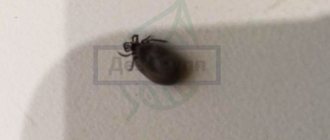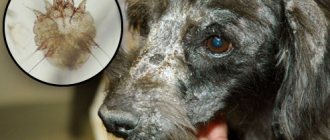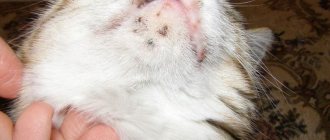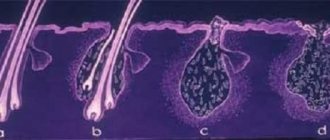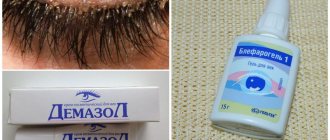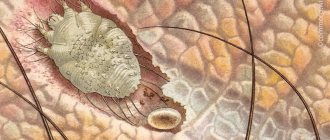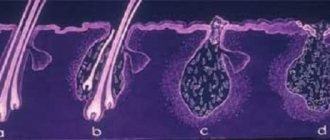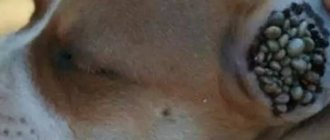- Acne treatment
- Rosacea Treatment
- Treatment of demodicosis
“ Subcutaneous mite ” sounds very unpleasant, and many may think that anyone can get this parasite, but “but not me.”
In fact, demodicosis - this is the name given to damage to hair and skin areas by a microscopic mite - is far from a rare phenomenon. And some cosmetic procedures can provoke an exacerbation.
Scientific fact: human skin can be parasitized by 2 types of Demodex , which feed on dead skin cells and live on the skin and hair follicles, including eyelashes and eyebrows:
- brevis;
- folliculorum.
As a result of their activity, a person feels itchy skin, redness, peeling appear, and the skin becomes rougher. If measures are not taken, all these unpleasant symptoms can develop into crusts and inflammatory elements.
What causes the disease
The subcutaneous mite lives on the human head almost constantly, but does not cause aggravation in healthy people. Severe symptoms occur with a sharp decrease in immunity when the parasite affects the deep layers of the skin. Also, the activation of the Demodex mite depends on the functioning of the sebaceous glands of the head, the endocrine system and the general resistance of the body.
Factors contributing to the proliferation of hair mites in humans:
- hormonal disorders;
- long-term use of antibiotics and corticosteroids;
- chemical effects on the scalp;
- incorrectly selected hair care products;
- alcohol abuse and smoking;
- unbalanced diet with a predominance of salty, smoked, spicy foods;
- lack of vitamins;
- psycho-emotional overload;
- menopause or reaction to taking hormonal contraceptives.
It has been established that the Demodex parasite on the head secretes a special enzyme that affects the composition of human sebum and causes swelling of the skin. With strong immunity, inflammation and swelling go away on their own. But when the parasites are activated, their number increases to thirty pieces in one sebaceous gland. This contributes to the manifestation of symptoms of the disease on the skin.
Demodex mites can be transmitted to others through direct contact, but the patient does not need to be isolated. In order for the disease to be transmitted to another, a number of factors must coincide, creating favorable conditions for the activation of the parasite.
How does a tick get to a person and why is it activated?
Subcutaneous hair mites form part of the healthy microflora of human skin and are saprophytes. The term means that they eat excess fat accumulations and dead skin cells, thereby helping to cleanse the epidermis. Opportunistic microflora begins to multiply rapidly as soon as too much sebum appears in the hair follicles. This happens when:
- daily abundance of fatty foods;
- regular use of oily cosmetics;
- excessive sunbathing;
- sudden change in temperature;
- disturbed hormonal imbalance;
- nervous disorders and frequent stress.
Signs of overcrowding of hair follicles with subcutaneous mites are manifested by demodicosis. This happens when a person’s immunity is weakened by some disease.
Symptoms
Symptoms of the presence of a mite in the hair begin with the appearance of rosacea. This is pronounced erythema, occurring against the background of swelling and redness on the head, accompanied by acne nodules and ulcers on the skin.
Characteristic symptoms of demodicosis of the scalp:
- redness of the skin that may spread to the chest and upper back;
- papules (nodules), pimples and blisters filled with pus;
- thickening of the skin in the affected area;
- pronounced vascular network;
- dry skin, tightness, flaking and itching.
Such signs of the presence of a subcutaneous mite may initially be invisible. But as the Demodex parasite actively multiplies, a person feels severe discomfort. He develops dandruff, hair follicles are damaged, pimples appear not only on the forehead, but throughout the entire hair growth area.
Features of demodicosis and the fight against it
There are a lot of signs of the development of demodicosis, but they are all very unpleasant. The thing is that the smallest mites leave products of their vital activity in the skin. This causes severe allergic reactions, so people who are diagnosed with demodicosis most often complain of redness of the scalp, severe peeling and enlarged pores, which leads to increased oiliness of the skin. All this causes a lot of inconvenience. In addition to physical discomfort, patients suffer from problems with their appearance, because it is very difficult to hide traces of demodex.
But there are methods to combat this scourge. Nowadays, you can buy a lot of effective products in pharmacies that quickly get rid of subcutaneous mites. But you can also use traditional methods. Many of them are safe and easy to prepare, so their use is acceptable even during pregnancy.
It is necessary to treat demodicosis. Hair mites multiply quickly and eventually spread throughout the scalp. As a result of their vital activity, the hair follicles begin to weaken, after which the strands will begin to rapidly thin out. The scalp will not receive enough beneficial elements, which causes severe flaking.
You can get rid of this problem quite simply. But you shouldn’t delay with medical therapy, as there is a risk of weakening your hair so much that it will begin to fall out in strands. It will be difficult to restore the fullness of your hair.
Which doctor treats demodicosis of the head?
First of all, you need to visit a dermatologist, who will give you a referral for tests and, based on their results, select a treatment regimen. For large areas of damage not only in the hair, but on the face, neck and back, the help of a dermatocosmetologist may be required. This is the doctor who determines your skin type. He will be able to select medicinal and cosmetic products and use them to treat problem areas. If the cause of the disease is poor immunity, the patient is referred to an immunologist. If hormonal disorders are suspected, an endocrinologist joins the treatment.
Conclusion
A mite on the head in the hair can live for quite a long time, but as soon as it begins to demonstrate pathogenic activity, you should immediately seek help from a specialist (see also the article “Seborrheic dermatitis of the scalp: unpleasant, but completely curable”).
And so that you can more accurately diagnose this disease and more fully study the accompanying symptoms, we recommend watching the video in this article.
Did you like the article? Subscribe to our Yandex.Zen channel
Text \ Photo Ekaterina Posted 01/21/2015
+2
share:
To favorites
To print
If you want to thank, add clarification or objection to the author - add a comment!
Currently being discussed:
- Lyubov Burkina
20.08.2018
What hair color should I choose? Please give me some advice. I don't know which one I have...
- I
19.08.2018
I had eyelash extensions for 6 months and took a break. After 3 months I increased it again...
- Vasilisa
18.08.2018
Cool hairstyle
18.08.2018
Hi, can I dye my bleached hair (currently red) bright purple...
16.08.2018
Hello! I am a dark girl with black eyes. I want to dye my hair dark...
15.08.2018
The photo shows young beauties. Can older ladies have their eyebrows done? Age...
Comments »
Diagnostics
Treatment of demodicosis of the scalp begins with proper diagnosis. Even in a healthy person, the Demodex mite lives in the epithelial tissues, so doctors pay attention not to its presence, but to its quantity. The choice of the appropriate examination technique is made by the doctor, since each of the procedures has advantages and disadvantages.
Existing methods for diagnosing demodicosis:
- Scraping from the surface of the affected skin - with its help, the affected area of the skin is assessed and the parasite is calculated per unit of skin area.
- Examination of the secretion of the sebaceous glands - part of the mite elements is squeezed out, the skin on the head is partially damaged.
- Superficial biopsy - examines parts of the epithelium and the contents of its glands.
- Skin biopsy followed by histological examination allows you to examine the secretion of the sebaceous glands.
- The study of eyelashes and hair reveals parasites in the follicles; the procedure does not cause much pain.
What is a hair mite
The mite that causes demodicosis capitis is known as Demodex folliculorum. The parasite lives in hair bags, which consist of connective tissue and surround the roots of the hairs. It is found not only under the skin on the head, but also on other parts of the body where there is hair. Demodex folliculorum is also called eyelash mite.
The body of the parasite consists of two parts, it is elongated and covered with scales. Due to them, the parasite is retained in the hair follicle. The tick moves with the help of 4 pairs of legs located on its front part. It feeds on fat and dead cells that accumulate in hair follicles.
Treatment
After receiving the test results, the doctor decides how to treat the disease, and the patient must complete the full course to avoid relapse. Therapy includes several areas - medications, skin care products and dietary nutrition.
Many patients prefer to use folk remedies. Doctors approve of this approach, because herbs and home recipes are safe, speed up recovery and complement the therapeutic effects of medications.
Immunity restoration
How to get rid of subcutaneous mites to prevent relapse of the disease? Since the parasite is activated when immunity decreases, it is necessary to restore the body's resistance.
List of drugs to strengthen immune defense and prevent demodicosis:
- vitamin complexes with a high content of phosphorus, calcium, iron and zinc;
- B vitamins and nicotinic acid;
- folic acid;
- Brewer's yeast;
- immunostimulating drugs in tablets and injections - Interferon, Cycloferon, echinacea tincture, Immunal.
If hair mites in people are activated under severe stress and emotional overload, they should be avoided. The doctor may prescribe sedatives.
In case of chronic demodicosis, drastic measures are taken to restore immunity - autohemotherapy. This is the introduction under the skin or intramuscularly to the patient of his own blood obtained from a vein.
Drug treatment
The use of medications for demodicosis is aimed at eliminating the mite and the consequences of its vital activity in the epithelial tissues. Metronidazole is used to treat the parasite. The first course lasts 6 weeks, during which the patient drinks 250 mg of the drug twice a day. After 2-3 weeks, the course is repeated, the dose of the medicine is the same.
In between, doctors prescribe 500 mg of purified sulfur taken orally along with meals twice a day. A five-day course is recommended to take Tinidazole 4 tablets per day and Hingamin 250 mg 2 times a day.
If the inflamed skin becomes covered with ulcers, and the patient scratches his head, causing a bacterial infection, antibiotics and antifungal agents are prescribed. These include Tetracycline, Erythromycin, Nystatin.
Folk remedies
In combination with strengthening the immune system and drug treatment of the skin, you can use traditional medicine recipes. These include washes, masks and scalp treatments.
Popular home remedies for hair mites:
- Tar soap - washing your hair inhibits the proliferation of parasites, cleanses the skin and restores its structure.
- Chatterbox - the product contains 10 tablets of Nystatin, Metronidazole and Levomycetin, ground into powder, as well as 100 ml of Dimexide and purified water. Prepare a fresh solution and treat the affected areas of the head with it for 2 weeks, 2 times a day.
- Calendula and Demalon ointment - in the morning you need to rinse your hair with water, after 15 minutes apply calendula tincture, and after 5 minutes spread the ointment on your skin. Leave the mask on until the evening, then wash your hair and treat with the tincture. The course of treatment is 30 days.
How to treat demodicosis with purified kerosene depends on how severely irritated and inflamed the scalp is. The product is applied to the affected areas for three days, then washed off. Kerosene cuts off the parasite's nutrition and access to oxygen due to the film created on the skin, which causes the tick to die.
If you do not want to prepare products according to folk recipes, you can purchase ready-made pharmacy shampoo that cures demodicosis. It can be used daily or as recommended by your doctor.
Shampoos
Treatment of demodicosis with shampoos helps to treat hard-to-reach areas of the skin. The products allow you to eliminate the symptoms of the disease on the skin, destroy mites and restore damaged epithelium after damage.
The most effective shampoos against hair parasites:
- Demodex Complex – reduces the number of mites, cleanses the skin of scales and dead particles. Used in treatment and prevention.
- Stop Demodex – relieves irritation, soothes the epidermis, suppresses the proliferation of parasites. For the best effect, apply the product to the head several times and leave for 3-5 minutes.
- Demodex Ovante is a natural-based product from an American manufacturer. Contains oils, vitamins, zinc, sulfur and plant extracts. Does not cause an allergic reaction, suitable for daily use for 14-28 days in a row.
Shampoos for the treatment of demodicosis are used simultaneously with medications and other external agents for better effect.
Diet
To achieve lasting results, in addition to cosmetics and medications, doctors recommend following a special diet. It is built according to the type of treatment table No. 5. The patient must adhere to proper nutrition during the entire course of therapy, in which case demodicosis of the scalp goes away faster.
It is necessary to exclude alcohol, spicy, salty and smoked foods, and sweets. To prevent blood from rushing to the head and the proliferation of parasites, food and drinks should be warm.
You cannot overeat; all food should be light, but nutritious. Preference is given to fruits, grains, vegetables, fiber, and herbs. It is recommended to consume low-fat meat and fish. Dairy and fermented milk products are beneficial.
A little about the life of a tick
Demodex folliculorum, which is the scientific name of one of these parasites in Latin, lives in the small hair follicles of the eyelashes. A follicle is a kind of root of each hair where its growth begins. In all forms, immature and adult, the mite consumes epithelial cells, leads to inflammation and enlargement of the follicle, and also increases keratinization of the skin of the eyelashes.
Demodex brevis is another representative of the causative agent of human demodicosis; it develops in microscopic sebaceous glands and their ducts, usually located on the skin of the face. Adult and immature forms of the tick consume the glandular cells of the glands as food, and therefore, in the case of severe infections, they can cause a very active clinical picture of inflammation of these glands.
It is thanks to the conditions of parasitism of these two types of mites, when symptoms appear in the eyelash area and spots very similar to acne are formed, that the disease in the first case was called a hair mite, and in the second - acne.
Useful links In the article What types of ticks are you can learn more about the variety of ticks in nature.
Several researchers have attempted to estimate the prevalence of Demodex folliculorum and brevis. An initial report in 1961 suggested a prevalence of 95%, but the parasites do not cause clinical disease in all cases. Ticks are always present in humans, but only when conditions are favorable for them do they transform into a pathogenic form and cause disease. Untreated demodicosis in humans in a timely manner can lead to madarosis - loss of eyelashes, as well as the formation of a large number of acne on the surface of the facial skin.
Infection with these parasites occurs equally often in men and women. The severity of clinical signs depends on the number of sebaceous glands, but in the case of the hair form - on the density of the hair follicles.
Regarding age, Demodex folliculorum was observed in 84% of the population sample with a mean age of 61 years and almost 100% in individuals over 70 years of age. A 2010 scientific study identified hair mites as a potential cause of childhood blepharoconjunctivitis, an inflammation involving the conjunctiva and eyelids.
Rules for caring for the scalp and hair during treatment
In the process of treating demodicosis of the skin, certain rules should be followed. Shampoo alone will not cope with the attack of parasites. Therefore, it is necessary to wash your hair with a medicinal product, and then reinforce the result with folk methods. Due to the fact that mites are most active in the evening and at night, it is best to treat the skin during this period.
Products in the form of scrubs are not recommended for use more than once every 7 days, so as not to disturb the natural oil balance of the skin and not damage it. Infusions of eucalyptus, oak bark, buckthorn, elecampane, and wormwood have a beneficial effect on the scalp and hair. Your hair should be washed daily. During treatment, hair coloring and perming should not be done.
Consequences of a tick bite for humans
A tick bite in itself is not dangerous to humans. Serious consequences after a bite can only occur if the insect has been infected.
A tick can be the source of quite a large number of diseases, so after removing the tick, save it for testing for tick-borne infections (tick-borne encephalitis, tick-borne borreliosis (Lyme disease), if possible, for other infections), this can usually be done in an infectious diseases hospital. You need to understand that the presence of an infection in a tick does not mean that a person will get sick. A tick analysis is needed for peace of mind in case of a negative result and vigilance in case of a positive result.
Here is a list of diseases that ticks can transmit:
- Tick-borne encephalitis;
- Lyme borreliosis;
- Tick-borne hemorrhagic fevers;
- Ehrlichiosis;
- Anaplasmosis;
- Tick-borne typhus;
- Smallpox rickettsiosis;
- Tsutsugamushi fever;
- Q fever;
- Paroxysmal tick-borne rickettsiosis;
- Human babesiosis.
The most common in Russia and pose a serious threat to human health are tick-borne encephalitis and borreliosis. Of course, the likelihood of becoming infected from a tick bite is not too high, because 90% of ticks, according to research, are sterile. However, it is present.
Prevention
To avoid infection with demodicosis, you should not use other people's bed linen and hygiene items. Linen should be changed frequently and ironed thoroughly. Feather pillows may contain mites, so it is worth replacing them with ones made of synthetic materials.
If itching and flaking appear, especially if you previously had demodicosis, do not comb or scratch the skin. It is better to immediately consult a doctor to be examined for ticks.
You should stop smoking and drinking alcohol, especially during treatment for parasites. Immunity needs to be increased by hardening, walking in the fresh air, playing sports and taking multivitamin complexes.
Demodicosis of the scalp is a disease that is provoked by several reasons. If a person has problems with the immune or endocrine system, or increased sebum production, then treatment will be aimed at eliminating these pathologies. Following medical recommendations, a combination of medications and folk remedies, as well as regular prevention will lead to quick positive results and lasting remission.
Author: Marina Ermakova, doctor, especially for Dermatologiya.pro
Why is hair mite infection dangerous?
If a person has activated a mite in his hair, then he will not be able to ignore it. The subcutaneous Demodex parasite can significantly reduce the patient’s quality of life. It does not sit still, but can move from the head to the eyebrows, eyelashes, and affect the area behind the ears. In addition to itching, severe flaking of the scalp and hair loss, demodex mites can cause:
- Stye on the eye. If a mite infects the follicles of the eyelids, the skin in the affected area immediately begins to itch, become inflamed and swell. After the stye goes away, several eyelashes fall out.
- Decreased vision. Visual function is impaired if the eyelash demodex mite progresses for a long time. The mucous membrane of the eyes turns red and becomes dry, which is why the eyes quickly get tired and react painfully to light. Vision is restored after suppression of demodex activity.
- Thickening of the skin on the head. Seals form in those places where the hair fell out in whole strands. These areas are especially inhabited by microscopic parasites, which causes the scalp to become loose and crusty.
The demodex mite differs from ticks that can transmit diseases from person to person in that it is part of the microflora of human skin. Its activity is provoked by diseases that disrupt the functioning of the sebaceous glands. Demodex often affects the eyelids of women during pregnancy due to changes in hormonal levels and weakened immunity. As soon as a woman’s health returns to normal, the signs of demodicosis disappear.
Conclusion: demodicosis is not an independent disease.
Facial demodicosis: video
https://youtube.com/watch?v=_o4dbTsKV9w
Treatment. First of all, you should be tested for demodicosis - the corresponding diagnosis is made when five adult individuals are found on one square centimeter of skin. The most effective treatment is considered to be a combination treatment of facial demodicosis, for which drugs for external use and systemic therapies are used, including immunomodulators, multivitamin complexes and dietary supplements containing minerals and amino acids. To relieve itching, it is advisable to take antihistamines (antiallergic) drugs, for example, Suprastin, Tavegil or Diazolin, and antiparasitic drugs, such as Metronidazole and Ornidazole. Treatment of demodicosis on the face is a long process, carried out in courses separated by short breaks. If the disease is detected at an early stage, then you can get rid of the tick in one to one and a half months, and in advanced cases, treatment of facial demodicosis can take up to a year. It is clear that the cure primarily depends on the rapid destruction of parasites, for which Metrogil, Demalan ointments are used, as well as compositions containing tar, sulfur, zinc, sodium thiosulfate, azelaic acid, benzyl benzoate, ichthyol and even mercury (yellow mercury ointment)
In addition, if you have facial demodicosis, it is very important to follow a diet: exclude spicy, salty and smoked foods, and also do not drink alcohol.
Symptoms Demodectic mange of the eyes in humans occurs as a result of damage to the facial skin by an arthropod parasite that has “populated” the follicles of the eyelashes. Common symptoms for this pathology are tearing and eyelash loss. The vast majority of people with demodicosis of the eye note itching, burning and a sensation of a foreign body in the eyes. Rapid eye fatigue and sensitivity to bright light also indicate the presence of parasites.
Peculiarities. Demodectic mange of the eye in humans is an extremely unpleasant disease that disfigures the appearance of a person who is forced to put up with persistent redness and inflammation of the edges of the eyelids. However, the most unpleasant sensations are caused by the abundant foamy discharge that collects in the corners of the eyes and between the eyelashes. When dried, the viscous secretion remains in the area of the eyelash edge in the form of extremely unaesthetic scales. Demodicosis provokes blepharitis (chronic inflammation of the eyelid margin) and aggravates its course.
Treatment. Demodicosis of the eye in a person is diagnosed by an ophthalmologist. For laboratory research, a specialist takes four eyelashes from the upper and lower eyelids and examines them under a microscope - this does not take much time and is done in the presence of the patient. Treatment of eye demodicosis is carried out comprehensively and involves the use of antibacterial, antihistamine, acaricidal (antiparasitic) and immunomodulatory drugs, which are used internally and externally. The minimum duration of treatment is usually about a month, and the maximum (if a secondary infection cannot be avoided) is a year. Effective treatment of eye demodicosis is possible only with strict adherence to hygiene measures to reduce the likelihood of re-infection.
Causes, routes of infection and provoking factors
The study of demodicosis has shown that in addition to a decrease in immune defense, there are other reasons that cause this pathology. One of the important points is the physiological state of human skin, namely, how correctly the sebaceous glands function, what is the composition of their secretions, as well as concomitant skin diseases and hormonal imbalances.
External influences on the hair and scalp also often lead to the development of the disease. Women are at risk of demodicosis because they constantly use various chemical reagents, as well as other aggressive substances found in cosmetic products for hair and skin.
These masks, gels, shampoos and paints disrupt the functioning of the sebaceous glands, dry the skin, which provokes a decrease in local immunity, and hence the development of pathology.
Immunity can protect a person from the occurrence of this disease, but only if it is strong enough. In this case, after the tick releases metabolic products, defense mechanisms are triggered and toxins are neutralized. When the body is weakened, they are unable to eliminate this problem; all the signs of demodicosis appear.
Reasons for decreased immunity:
- Imbalance of hormones in the body.
- Incorrect use of cosmetics, use of low-quality cosmetics products, exceeding the permissible standards in applying them to the hair.
- Long-term therapy with antibacterial drugs and hormonal drugs.
- Poor diet, excessive consumption of sweets, foods with large amounts of preservatives, as well as low-grade dyes.
- Drinking large amounts of drinks containing caffeine.
- Bad habits such as smoking and alcohol abuse.
- Excessive consumption of salty and spicy foods, as well as chips and fast food.
- Abuse of thermal procedures in saunas, baths, solariums, frequent hot baths. In warm weather, ticks begin active life.
We must not forget about the possibility of infection with a tick from another person, therefore the use of other people's hygiene items, combs, towels and other things is contraindicated. After shaking hands with people or being in public places, you must wash your hands. A sick person constantly scratches his head, and pathogens remain on his fingers, which are easily transmitted through shaking hands.
People diagnosed with demodicosis of the head and other parts of the body are not considered contagious and do not need to be isolated, since every person has the parasites that cause the pathology
It is important to control the activity of these mites through the above measures.
In addition to the described human-dependent reasons for tick activation, there are also pathological reasons:
- diseases of the endocrine system;
- AIDS and HIV infection;
- pathologies of the gastrointestinal tract;
- trichomoniasis;
- depression and other emotional disorders;
- metabolic disorder;
- frequent colds and viral diseases;
- infectious and other chronic diseases.
In addition, children can be included in the risk group for such a disease, since their immune system is not yet sufficiently developed. Elderly people are also more susceptible to demodicosis than others, since their bodies are weakened due to age-related changes.
